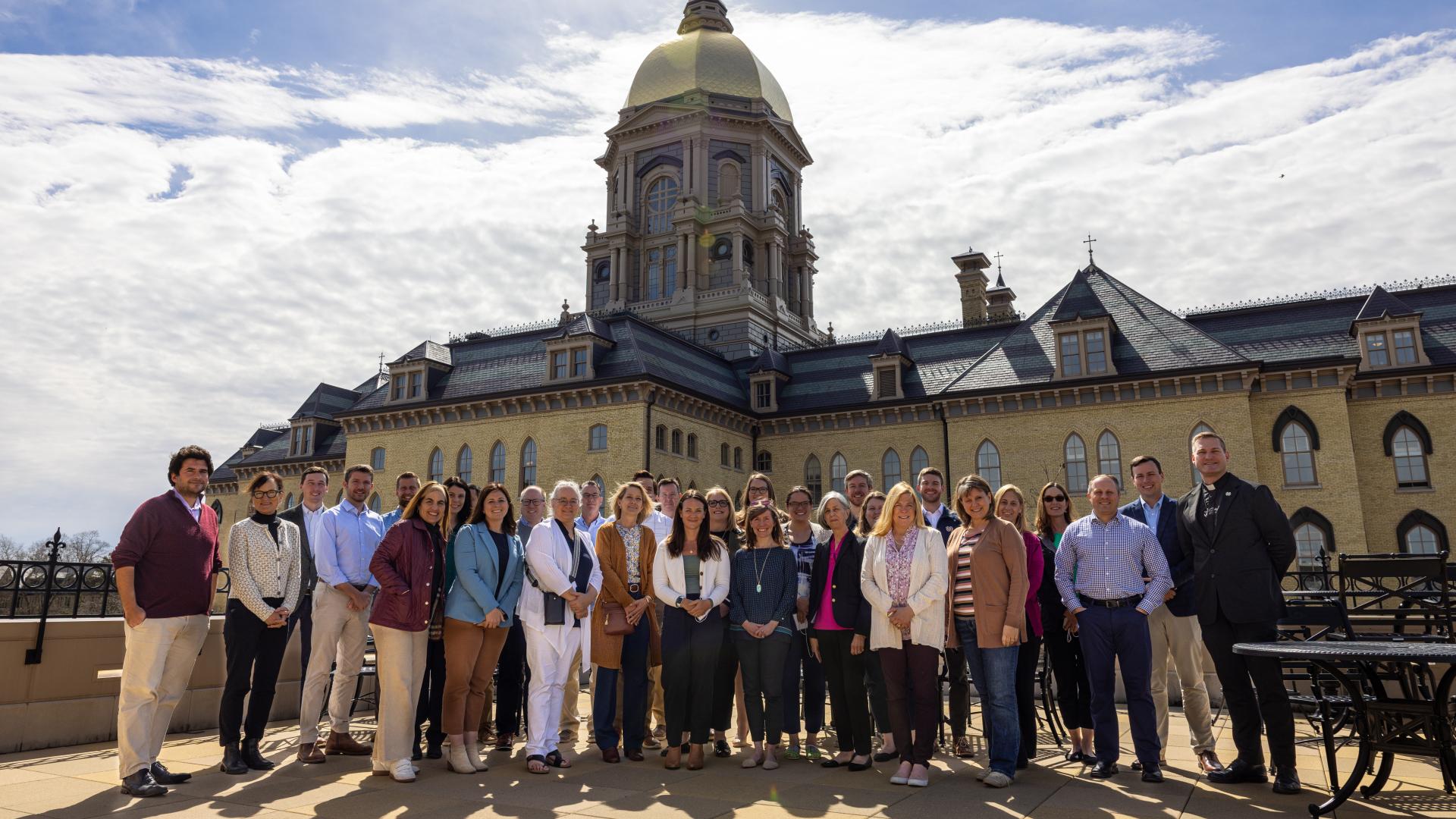How can technology transform learning experiences? The eighth annual Blended Learning in Catholic Schools Symposium (BLiCSS 8.0) brought together scholars, administrators, and educators to around that question. This year’s theme—“Leveraging Technology Across the Curriculum”—issued a challenge to speakers and attendees alike: to understand emerging tools like generative AI and lead with purpose in using them to serve every learner. How can technology deepen student engagement, empower inclusive practices, and sustain a rigorous academic culture grounded in Catholic values? These questions animated our conversations throughout the symposium.
As much as we’d love to capture every insight from this gathering of thought leaders and innovators, we’ve distilled the experience into eight key takeaways—continuing our tradition of reflection and sharing from BLiCSS (see BLiCSS 6.0 and BLiCSS 7.0)
Takeaway #1: A Collective Eyebrow Raise Toward EdTech

Over the past year, we’ve perceived a growing wave of concern around educational technology. Parents, educators, professors, and policymakers have all applied increasing pressure on edtech providers and practitioners. Their questions have become more critical: Are these tools genuinely helping students learn? Do the benefits outweigh the costs—especially when it comes to attention, well-being, and developmental needs?
Lewis Poche, shared that This spirit of caution and curiosity has led to what we call a “collective eyebrow raise.” There’s a shared sense of skepticism and responsibility. We are in a moment when educators, parents, and policymakers are pausing to ask not just whether we can use technology, but whether we should, and to what end.
Much of it echoes broader cultural reflections, including those raised in Jonathan Haidt’s The Anxious Generation. While The Anxious Generation primarily addresses adolescents’ personal tech use, the implications spill over into education: If these tools have such power to shape young lives, how do we wield them wisely in our classrooms?
Takeaway #2: It’s Not Just the Tool—It’s the Time and Place, Too

Too often, educators focus on what technology we’re using rather than when and why we’re using it. But the real question is: does this tool transform learning in this moment—or does it distract from it? Thoughtful technology use isn’t about novelty; it’s about leverage.
Fr. Nate Wills shared that one way to think about this comes from a familiar image in physics. Archimedes once said, “Give me a lever long enough and a fulcrum on which to place it, and I shall move the world.” Technology has the potential to be that lever—but only if we place it on the right fulcrum: a clear instructional purpose, a well-timed application, and a deep understanding of what students need in that moment.
When we use technology with that kind of intentionality, we do more than enhance a lesson—we create opportunities to deepen learning. We can design experiences that push students to think critically and connect meaningfully with content. With the right timing and purpose, technology becomes a lever not for substitution, but for transformation.
Takeaway #3: Is EdTech a Parasite or a Partner?

Dr. Matt Wilsey offered a biology-inspired analogy for evaluating the role of technology in classrooms: is it a parasite (taking more than it gives), a commensal organism (benefiting without helping or harming), or a true symbiotic partner (benefiting both the user and the learning process)? This framework encourages educators to ask whether a given tool genuinely adds value to student learning—or simply takes up time and attention.
To illustrate this, he compared a traditional hands-on activity using Hot Wheels cars with a digital simulation from PhET. While the physical version offers tactile engagement, the simulation instantly visualizes complex concepts like friction, potential energy, and kinetic energy—bringing abstract ideas to life in ways that might otherwise remain invisible. Students may lose some of the physical manipulation, but they gain access to scientific modeling and immediate feedback that deepen understanding.
In cases like this, technology doesn't just replicate the analog experience—it transforms it. That’s the hallmark of a symbiotic relationship: when the tool actively supports and strengthens the learning process rather than just coexisting with it.
Takeaway #4: Technology That Brings the Past to Life

Prof. Mark Johnson shared a moment that many teachers can relate to. After painstakingly developing a lesson on World War I—complete with a carefully crafted gallery walk filled with powerful primary sources, including documents and images that captured the emotions and experiences of those who lived through the lead-up to and aftermath of the war—he felt confident his students had engaged deeply with the material. It was a case study in high-quality, meaningful instruction rooted in historical inquiry.
At the end of the activity, one high school student shared her critique: the lesson was good, but “I wish I could have learned from someone who was there.”
Sometimes, teachers just can’t catch a break.
Johnson reflected on how emerging tools—like Hello History, a generative AI platform that allows users to “converse” with historical figures—might be a start at satisfying that student's impossible request. When used thoughtfully, such tools can foster historical empathy, helping students move beyond facts and timelines to encounter the complexity, humanity, and emotion of those who lived it.
Takeaway #5: Pencil and Paper: Innocent Until Proven Guilty

Dr. Patrick Kirkland set a high bar: “Pencil and paper are innocent until proven guilty.” Not because they’re nostalgic, but because they work—and because any technology used in their place must clearly outperform them. In other words, educators shouldn’t default to online worksheets or flashy tools simply because they exist. Instead, they should demand that technology justify its role by meaningfully enhancing the learning experience.
That doesn’t mean there’s no place for tech in math classrooms—it means we need to be strategic. When used well, technology can offer powerful advantages: adaptive practice with immediate feedback, opportunities for spaced repetition, dynamic visualizations of abstract concepts, and rich data to inform instruction. To explain his point, Patrick demonstrated how a tool like Desmos can help expert teachers surface student thinking and misconceptions in real-time.
Ultimately, the shift must be from what program is used to why it's being used. Technology earns its place when it supports how students learn best—not just when it feels new or convenient.
Takeaway #6: Forming Better Writers, Not Just Better Writing

Dr. Katie Lee, Dr. Kati Macaluso, and Maura Maloney reminded us that writing is not simply speech written down—it’s an iterative, multidimensional process of meaning-making. In the age of generative AI, our goal isn’t just to help students produce more writing, but to help them become better writers—deep thinkers who can critically evaluate text.
One powerful way to do that? Have students evaluate AI-generated writing. The presenters challenged attendees to try this out for themselves. When asked to assess AI-generated responses to questions like “Did Romeo and Juliet cause their own deaths?” students don’t just analyze content—they learn to interrogate the structure, strength, and logic of an argument. This kind of exercise doesn’t diminish the teacher’s role; it amplifies it. It positions the teacher as a guide in helping students become not just content consumers, but thoughtful critics of the output of generative AI.
Takeaway #7: Building Better Questions with AI

Dr. Alex Ambrose encouraged educators to use AI to elevate assessment design—and to do so with intentionality. Ambrose champions the use of general-purpose AI tools like ChatGPT over pre-packaged “AI wrappers.” His approach emphasizes thoughtful, ground-up design: crafting custom prompts that align closely with instructional goals. While not the only method, it highlights the importance of teacher expertise, front-end planning, and clarity of purpose when integrating AI into assessments.
Central to Ambrose’s strategy is the use of question taxonomies—frameworks like Bloom’s Taxonomy that help educators design questions across levels of cognitive demand. Rather than defaulting to recall-based prompts, teachers can use these frameworks to push students toward deeper thinking: analysis, evaluation, and creation. When paired with AI, these taxonomies empower educators to co-construct assessments that are both rigorous and responsive to students’ needs.
Takeaway #8: UDL, AI, and the Catholic Classroom

Dr. Sean Smith challenged educators to see AI not just as a tool for efficiency, but as a powerful ally in creating more inclusive classrooms. Framed through the lens of Universal Design for Learning (UDL), his session emphasized that meeting the needs of all learners—especially those with learning differences—is not optional. It’s central to our mission as Catholic educators committed to honoring the dignity and potential of every student.
He provided practical strategies for how AI can support inclusive practices. For example, educators can use AI to audit slide decks for alignment with lesson objectives and ensure that key content is conveyed through multiple modes—text, visuals, summaries, and supports like audio or translation. These adjustments aren't just helpful for some students; they improve clarity and accessibility for all.
To bring this to life, Dr. Smith led a demo of Diffit, a tool that helps teachers differentiate materials by automatically generating leveled summaries, vocabulary lists, and question sets tailored to students' reading levels. Tools like Diffit illustrate how AI can remove barriers to access while helping educators preserve instructional rigor.
Dr. Smith’s message was clear: inclusion isn’t an add-on—it’s a calling. With the right tools and thoughtful implementation, AI can light the path toward a more accessible, personalized, and faith-centered learning experience for every student.
Whether we’re using avatars to explore the past, simulations to visualize scientific concepts, or AI tools to craft better questions, one truth remains: technology doesn’t define the future of Catholic education. But how we use it—creatively and intentionally—absolutely will.
BLiCSS 8.0 reminded us that leveraging technology across the curriculum isn’t about adopting new tools; it’s about renewing our commitment to deep learning, inclusive practices, and formation. As leaders in Catholic education, we’re called not just to keep up—but to lead with clarity, conscience, and care. And with the right questions, the right timing, and the right mindset, we can ensure that technology serves the learner—not the other way around.
Since 2015, Higher-Powered Learning has empowered Catholic school teachers and leaders to leverage technology and related innovative research-based educational practices to meet the needs of all learners.
Subscribe to the "Higher-Powered Learning News" list to join us in this mission.
If you have any questions about Higher-Powered Learning, please contact our team at hpl@nd.edu.
 Alliance for Catholic Education
Alliance for Catholic Education

